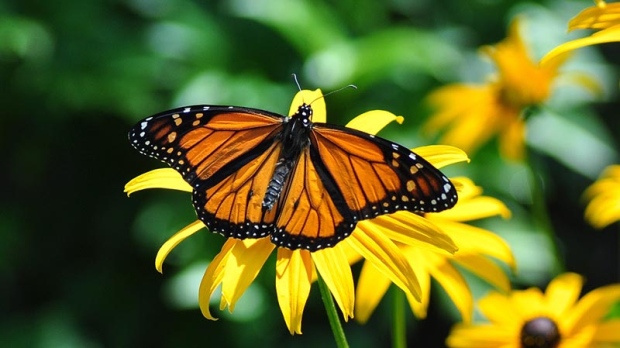A commonly used neonicotinoid pesticide may have significant lethal and sublethal effects on monarch butterflies, new University of Guelph research has revealed.
The findings could offer another possible explanation for the massive decline in the North American monarch population over the last few decades.
Led by U of G integrative biologist Dr. Ryan Norris, the two studies examined the impact to monarch caterpillars raised on milkweed treated with clothianidin, an insecticide that is coated on soy and corn seeds and taken up into the foliage.
In a first-ever field-based study, Norris, Dr. Tyler Flockhart from the University of Maryland Center for Environmental Science and colleagues examined how caterpillars raised on milkweed treated with clothianidin fared in the wild.
Their study, published in the Journal of Animal Ecology, found the caterpillars had lower survival rates than those raised on untreated milkweed, although the egg-laying abilities of the surviving adults did not appear affected.
In a separate lab-based study, published recently in The Canadian Entomologist, led by post-doctoral researcher Dr. Alana Wilcox, with Dr. Amy Newman and Norris, the team investigated the effects of the neonic on growing caterpillars.
They found that those raised on treated milkweed were significantly smaller and lighter than caterpillars that fed on untreated milkweed, with less than half their overall volume.
“These findings are worrisome,” said Wilcox. “Given that the vast majority of corn and soy crops in North America are using neonicotinoid-coated seeds, and much of the milkweed that monarchs feed on grows in agricultural areas, it is concerning to find these negative effects on larval development and survival.”
Even more worrisome for Norris is the finding that monarchs may actually prefer milkweed grown in pesticide-treated soil.
Monarchs lay eggs only on milkweed plants. The field research team found that over two years, monarchs laid more eggs on milkweed that had been treated with field-realistic concentrations of clothianidin compared to untreated milkweed.
More study is needed to understand why monarchs may be more attracted to milkweed grown in soil treated with clothianidin. There may be fewer insects that prey on monarch eggs or the plants may contain more nitrogen or other nutrient.
Whatever the reason, the neonic-grown milkweed then becomes an “ecological trap” for the butterflies, Norris said. His team found that the caterpillars that emerged from eggs raised on treated milkweed had a three-per-cent lower survival rate than those raised on untreated milkweed, after controlling for variations in milkweed density and year-over-year survival differences.
“While this may appear to be a small difference, when one considers that monarchs lay millions of eggs in North America each year, that lowered survival rate could result in a measurable effect on the monarch population,” said Flockhart.
For those caterpillars that survived to the pupa stage, the field-based nature of the study meant that the research team could not make subsequent estimates of the longevity of the resulting adult monarchs.
In the second study, Wilcox along with Norris and Newman grew milkweed in the lab in high and low levels of clothianidin as well as without the neonic. They then raised monarch caterpillars on the plants and tracked their weight and size through their five normal moults, called instars.
At the fifth instar, the body volume of the caterpillars from the high-dose treated milkweed was, on average, less than half that of other groups. These caterpillars also had a lower mass than the other groups.
One positive finding was that the neonic exposure did not appear to affect the number of eggs the monarchs went on to lay nor their egg size.
Taken together, Norris said, the findings of the two studies suggest that neonicotinoid-affected milkweed may be another potential reason for the decline in monarchs.
“Neonicotinoids have been shown to have both lethal and sublethal effects in other invertebrate and pollinator species, so we were not surprised to see that monarch larvae also seemed to be affected.”















